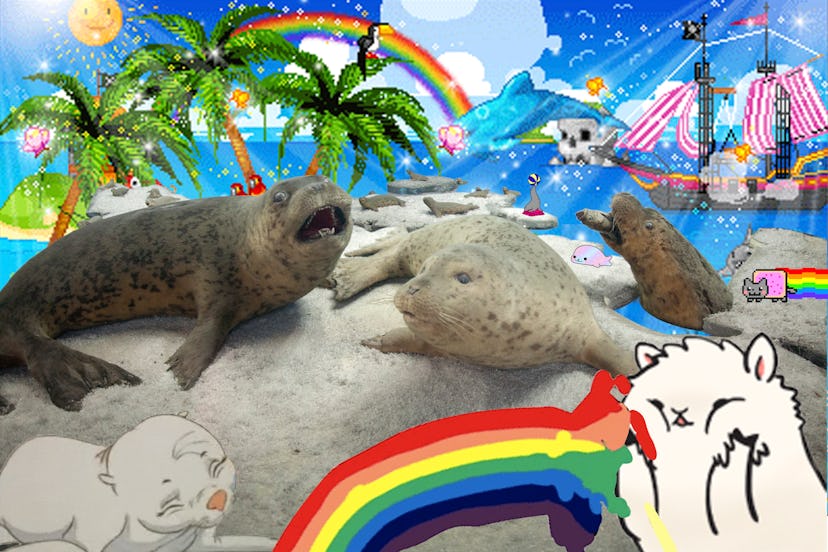Meet Miao Ying, the Young Internet Artist Breaking Through China’s Firewall
The 31-year-old artist’s sharp satire of China’s internet censorship is turning her into an international star, with her work popping up everywhere from Art Basel Hong Kong to the New Museum.

Recently, at Art Basel Hong Kong, and exhibitions coinciding with the fair, in Hong Kong, Shanghai, and Beijing, one couldn’t avoid the work of Miao Ying, the young Chinese artist whose official bio states that she “resides on the Internet.” At “.com/.cn,” a show curated by MoMA PS1’s Klaus Biesenbach and Peter Eleey at K11’s pop-up space in Hong Kong, visitors could sit inside her installation landscape.gif, surrounded by multiple iPads playing amateur-style GIFs. Her work popped up again in Shanghai, at another K11 show curated by the New Museum’s Lauren Cornell, “After Us,” and in Beijing at UCCA’s “The New Normal.” At the Art Basel fair, Modern Media, China’s mightiest luxury publishing platform, her APP-Nosis series, a sendup of touch-screen branding, decorated the booth to promote a new art-guide app; not far away, her work was being shown by Galerie nächst St. Stephan Rosemarie Schwarzwälder of Vienna. And, of course, anyone could pull up her 2016 digital exhibition with the New Museum, “Chinternet Plus,” on their phone. Meanwhile, soon she will be in Rhizome’s Seven on Seven panels alongside artists such as DIS, Bunny Rogers, and Jayson Musson. The perk of being an artist who lives on the internet is that you can be literally everywhere.
A few days ago, I met up with Miao, who really lives in New York, at the fair in Hong Kong in real life. She was wearing a black windbreaker embroidered with nonsensical, corporate-looking logos that read “Comfortable” and “Never.” It was a 50 RMB buy, or less than $10, on Taobao, which is basically China’s eBay. It’s also where she ordered her painting on view at Basel with her gallerist, titled Effect #2 (2017), after giving a seller her specs. The resulting work—a black space peppered with campy official 2008 Olympics symbols of fireworks and rings that Miao bought in an effects package—had literally been passed through filter after filter. It looked like a painting but it was the product of the internet.
From the series Landscape.gif. Courtesy of the artist.
A wave of young post-Internet Chinese artists (Lin Ke, aaajiao, Lu Yang, Liu Yefu, to name a few) create work out of the surplus of online information available in a recently-booming, now-flatlining China—and, in Miao’s case, out of the negative space left by a restricted Chinese internet. According to the first-ever Art Basel and UBS Global Art Market Report, released at the fair, China makes up 21% percent of the art market—third in the world. Online sales account for just 8% in the dealer sector. The report, however, failed to suggest what percentage of this work lives online, which in many cases circumvents the market as well as, by extension, censorship.
Take Miao’s use of GIFs. It’s one of few forms of communication that cannot be easily monitored or censored online in China. On WeChat, China’s social-media mega-platform, GIFs are exchanged in most conversations, and the most popular, no doubt, explicate sex or politics. “You can really collect,” Miao said. “You want a GIF? I’ll give it to you for free.”
Content Aware, 2016, installation view at MadeIn Gallery. Courtesy of the artist and MadeIn.
Her series, LAN Love Poem.gif, evolved out of this kind of thinking. She dedicates each piece to a blocked form of social-media in China, with paeans made out of GIFs, emo-style Chinese internet poetry, tacky stock images, and screenshots. Each catalogues living on the internet in a place where the internet has perceivable boundaries: “You know YouTube is not going to open,” Miao explained. “Why are you trying so hard?”
She often, in these works, compares the compulsion and disappointment of dealing with the Great Firewall to relationships: breakups, jealousy, obsession. She’s prone to hyperbolic talk about the internet in total deadpan (“Without Google maps, I’m nothing,” she said casually at one point) and quirky metaphors to describe bond wih the Chinese internet, which she often describes in interviews as a kind of Stockholm syndrome: “You develop this bond with the person. You fall in love with them.”
Chinternet+, 2016-17, installation view at UCCA. Courtesy of the artist.
Last year, she showed “Chinternet Plus” with the New Museum via its virtual exhibitions program, creating a spoof of the opaque “Internet Plus” strategy introduced by the Chinese government in 2015. In Miao’s version, however, there’s only branding, no content: the site breaks down into novice-style GIFs and nonsense language. It’s essentially an exercise in packaging a worthless idea.
The work recently appeared as a series of videos in UCCA’s “The New Normal,” in Beijing. One video features a GIF of clapping celebrity memes around a failing-to-load Chairman Mao. Local authorities, who regularly survey work to be exhibited in China, said the work had to leave the show, so she just further obscured the image—and in the process further proved her point.
“The fact that this was among the least subversive elements of the piece for me actually adds to the irony of the work,” UCCA director Philip Tinari said of the episode.
There is one recent internet phenomenon, of course, that has stunned everyone, including Miao: the rise and current presidency of Donald Trump. “Everybody thought, He doesn’t exist. He’s just online,” she said, referring to his Twitter avatar in particular. “Now virtual reality is leading reality.”
Chinternet+, 2016-17
Watch Kendall Jenner channel performance art icons Marina Abramovic and Yoko Ono: